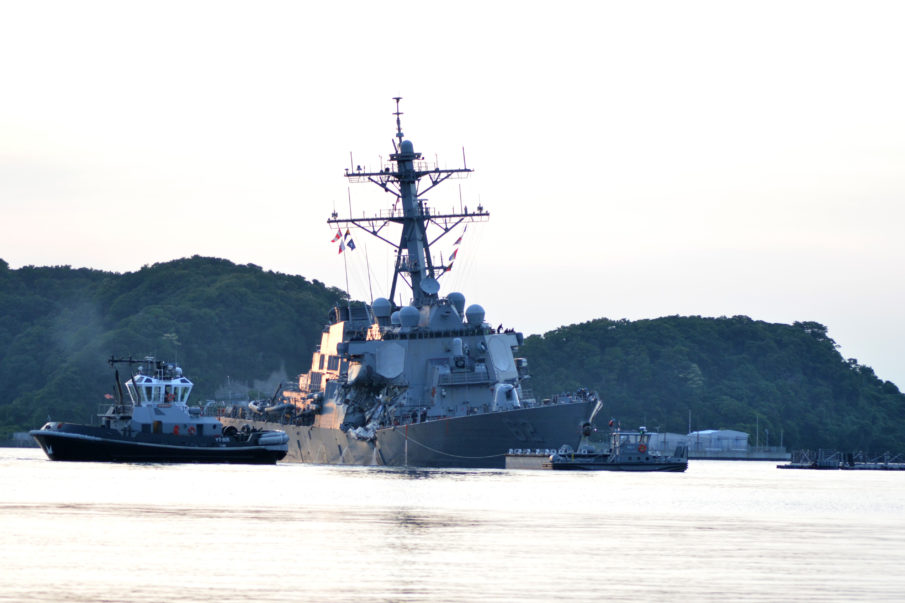Ever since the deadly June 17th collision between the U.S. Navy’s Arleigh Burke Class destroyer, the USS Fitzgerald and a significantly larger merchant ship in the Tokyo Bay, speculation has been rampant about who could be to blame for such an egregious error. Although the investigation has not yet been completed, the U.S. Navy announced on Thursday that they would be relieving the ship’s command of duty.
Despite the ongoing investigation, the U.S. Navy has made it clear that while the fault may not have been entirely on the USS Fitzgerald, the incident could not have occurred if the ship’s bridge crew had properly been attending to their duties. While the crew of the ACX Crystal, the merchant ship that collided with the Fitzgerald, may have been able to act faster to avoid the collision, this incident and the Navy’s decision, clearly indicate that the crash, which happened in clear weather, was the result of failed leadership on the destroyer.
The collision was avoidable and both ships demonstrated poor seamanship. Within Fitzgerald, flawed watch stander teamwork and inadequate leadership contributed to the collision that claimed the lives of seven Fitzgerald sailors, injured three more, and damaged both ships,” the 7th Fleet said in a statement.
Commander Bryce Benson, who was seriously injured in the collision, has been formally relieved of his command, after being temporarily relieved for medical care after the incident. As the ship’s commander, Benson was ultimately responsibility for the safety of the ship and its crew.
With absolute accountability for the safe navigation of Fitzgerald, Cmdr. Bryce Benson was relieved due to a loss of confidence in his ability to lead,” the Navy said, before adding that he’s being reassigned to Naval District Washington at the Washington Navy Yard in order to have continued access to the medical facilities there.
Commander Sean Babbitt and command master chief, Master Chief Petty Officer Brice Baldwin were both also relieved from duty as a result of the incident. According to the Navy, their “inadequate leadership” directly contributed “to the lack of watch stander preparedness and readiness that was evident in the events leading up to the collision.”
According to the statement, several junior officers have also been relieved from their posts, “due to poor seamanship and flawed teamwork as bridge and combat information center watch standers.” Other administrative actions were reportedly taken against officer and enlisted members of both the bridge and combat information center watch teams. It seems likely that the administrative action came in the form a non-judicial punishment, or the lesser NAVMC 118(3) remark, commonly called an administrative remark in their service record.
There are a lot of sailors” who have undergone the non-judicial punishment process and “survived and done well,” Vice Chief of Naval Operations Adm. William Moran told reporters at the Pentagon late Thursday, but “when you look at what happened here, it’s going to be pretty hard to recover from this.”
Important to note, however, in both the Navy’s press release and the subsequently released Supplemental Line of Duty Investigation into the incident, Navy officials took note of the efficiency, bravery, and “toughness” exhibited by the crew of the Fitzgerald in the aftermath of the incident. Thanks to the crew’s efforts, the ship was saved from the possibility of sinking, and more importantly, a number of lives that could have been lost were not. The investigation, in particular, points out that nothing in the crew’s power after the incident could have prevented the flooding of the crew compartment that claimed the lives of the seven sailors.
Following the collision these Sailors responded with urgency, determination and creativity to save their ship. Their rigorous damage control efforts and dauntless fighting in the immediate wake of the accident prevented further loss of life.” The release said.
Already have an account? Sign In
Two ways to continue to read this article.
Subscribe
$1.99
every 4 weeks
- Unlimited access to all articles
- Support independent journalism
- Ad-free reading experience
Subscribe Now
Recurring Monthly. Cancel Anytime.
Image courtesy of the U.S. Navy









